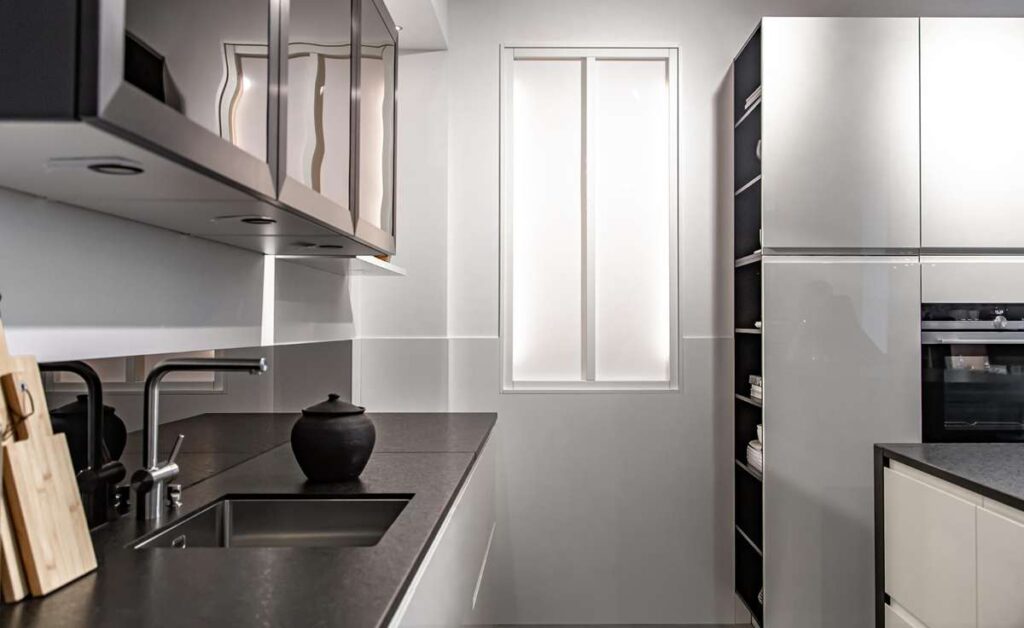Have you ever asked yourself, how deep are kitchen cabinets? It’s a good question, especially if you’re planning a kitchen makeover or buying new cabinets. Understanding cabinet depth helps you choose the right ones for your space. In this simple guide, we’ll explain everything about cabinet sizes in a way that’s super easy to follow. Let’s jump right in!
What Does “Cabinet Depth” Mean?
When we talk about cabinet depth, we are simply talking about how far the cabinet goes from the front to the back. It’s the distance between the cabinet door and the wall behind it. Depth is important because it decides how much stuff you can fit inside and how your kitchen feels when you move around.
Cabinet depth is usually measured in inches and can change depending on the type of cabinet like base cabinets, wall cabinets, or tall pantry cabinets.
Why Depth Matters in a Kitchen
Choosing the right cabinet depth is super important for a kitchen that works well. Here’s why:
- More Storage: Deeper cabinets can hold bigger pots, pans, and kitchen tools.
- Easy Access: Shallow cabinets make it easier to reach things without stretching.
- Appliance Fit: Depth makes sure your appliances like ovens and refrigerators fit just right.
- Better Flow: Right-sized cabinets help you move around easily without bumping into things.
Standard Depths for Kitchen Cabinets
When you are planning your kitchen, knowing the standard cabinet sizes can make everything a lot easier. How deep are kitchen cabinets usually depends on the type of cabinet you choose. Most cabinets follow simple, common measurements that fit well in any kitchen.
Here’s a quick look at the typical cabinet depths:
| Cabinet Type | Standard Depth |
| Base Cabinets | 24 inches |
| Wall Cabinets | 12 inches |
| Tall Cabinets | 24 inches |
Base Cabinet Depth
Base cabinets are the ones that sit on the floor and hold up your kitchen countertops. They are the foundation of most kitchen layouts.
- Standard depth: 24 inches from front to back.
- Some kitchens use deeper base cabinets (like 30 inches) to fit bigger countertops or add extra storage.
Wall Cabinet Depth
Wall cabinets are the ones that hang above the counters. They are perfect for storing plates, glasses, and other light kitchen items.
- Standard depth: 12 inches.
- They are shallower than base cabinets so you can easily reach everything without hitting your head or stretching too far.
Tall Cabinet Depth
Tall cabinets are like big standing closets for your kitchen. They are often used as pantries to store food or large kitchen items.
- Standard depth: 24 inches.
- Some tall cabinets may be even deeper if you need more space, but 24 inches works for most kitchens.
Custom Cabinet Depths
While standard sizes work for most kitchens, sometimes you need something a little different. That’s where custom cabinet depths come in! Custom cabinets are made to fit your unique space and needs.
Here are a few times when people might choose custom cabinet depths:
- Small Kitchens: If your kitchen is tiny, you might need shallower cabinets to save space and make it easier to move around.
- Wheelchair Access: Lower and shallower cabinets can make it easier for someone in a wheelchair to reach everything comfortably.
- Special Appliances: Some kitchens have bigger or smaller appliances that need custom-sized cabinets.
- Unique Designs: If you want a special kitchen layout or a one-of-a-kind look, custom cabinet depths help make it happen.
Factors That Affect Cabinet Depth
When deciding on the depth of your kitchen cabinets, there are a few important factors to keep in mind. Your choices will depend on things like your kitchen size, appliances, and even your style preferences. Let’s take a look at what affects cabinet depth:
- Homeowner Needs: Everyone uses their kitchen differently. If you have a lot of kitchen tools and want more storage, you might need deeper cabinets. If you’re someone who prefers a minimalist look, you might choose shallower options.
- Appliance Size: Larger appliances, like big ovens or refrigerators, might need deeper or custom cabinets to fit perfectly. Be sure to measure your appliances before choosing cabinet depth!
- Kitchen Size: If you have a small kitchen, shallow cabinets might be the best choice to save space. Larger kitchens can handle deeper cabinets for more storage.
How to Measure Cabinet Depth
Measuring cabinet depth is easy when you follow a simple step-by-step guide. Here’s how you can do it:
- Get a Measuring Tape: Grab a measuring tape or ruler to get accurate measurements. Make sure it’s long enough to measure from the front edge to the back of the cabinet.
- Measure from the Front Edge to the Back Wall: Place the measuring tape at the front edge of the cabinet (where the door or drawer opens) and pull it all the way to the back wall of the cabinet.
- Check Inside Space Too: Don’t forget to measure the inside depth of the cabinet. This will tell you how much space you have for storage and how deep you can place your items inside.
Tips for Choosing the Right Cabinet Depth

Choosing the right cabinet depth can make a big difference in your kitchen’s functionality. Here are some quick tips to help you decide:
- Think About What You Need to Store: Consider what you plan to keep in your cabinets. If you have big pots or appliances, go for deeper cabinets to fit everything.
- Check Your Kitchen Space Carefully: Measure your kitchen carefully to ensure the cabinets won’t make the space feel cramped. If your kitchen is small, shallow cabinets may work better.
- Don’t Forget Appliance Sizes: Remember to check the size of your appliances. Larger ovens or refrigerators might need more cabinet space to fit comfortably.
- Ask a Professional if Unsure: If you’re unsure about what depth is best, consult with a professional. They can guide you to the right choice based on your needs.
Common Mistakes When Picking Cabinet Depth
Picking the right cabinet depth is important, but it’s easy to make mistakes. Here are some common errors and how to avoid them:
- Choosing Depth Without Measuring Your Space: One of the biggest mistakes is not measuring your kitchen carefully. Always check the available space before deciding on cabinet depth. Cabinets that are too deep may make the kitchen feel cramped.
- Ignoring Appliance Size: Some people forget to consider the size of their appliances. If you have a large refrigerator, oven, or dishwasher, you might need deeper cabinets to fit them. Don’t assume one size fits all!
- Not Considering Storage Needs: Another mistake is not thinking about what you need to store. Don’t choose too shallow cabinets if you need to store big pots, pans, or small appliances.
- Choosing Style Over Function: Sometimes, people focus too much on the look of the cabinets and forget about functionality. While style matters, your kitchen cabinets should fit your needs. A stylish cabinet that doesn’t hold what you need isn’t helpful.
- Forgetting About Access: If you have limited mobility or need easy access to cabinets, don’t pick too deep. Shallow cabinets might be more accessible and easier to reach.
FAQS
Can I change my cabinet depth later?
It’s possible to change cabinet depth, but it can be costly and time-consuming. It’s easier to decide on the right depth during the initial design or remodel phase.
Are deeper cabinets better?
Deeper cabinets offer more storage space, which is great for larger items. However, if your kitchen is small, deeper cabinets might make the space feel crowded.
What depth is best for small kitchens?
For small kitchens, shallow cabinets around 12–18 inches deep are ideal. These will help save space and keep the area feeling open and uncluttered.
How deep are kitchen drawers?
Kitchen drawers are typically about 22 inches deep. This allows for easy storage of utensils, pots, and pans.
How deep should a pantry cabinet be?
A pantry cabinet should be around 24 inches deep to store larger items like cans and boxes. Deeper options can be used if you need more space for bulkier items.
What is the standard depth of a kitchen cabinet?
The standard depth for base kitchen cabinets is 24 inches, while wall cabinets are usually 12 inches deep. This is the most common measurement used in kitchens.
Can cabinets be 18 inches deep?
Yes, cabinets can be 18 inches deep, especially for narrow or smaller spaces. These are often used in places where full-depth cabinets would take up too much space.
How deep are kitchen base cabinets UK?
In the UK, the standard depth for base kitchen cabinets is typically 600mm (about 23.6 inches). This is very close to the standard depth used in many other countries.
Why are kitchen cabinets 24 inches deep?
Kitchen cabinets are usually 24 inches deep because this provides a good balance between storage space and accessibility. It’s deep enough for most kitchen items but not so deep that it wastes space.
Can kitchen cabinets be 20 inches deep?
Yes, kitchen cabinets can be 20 inches deep. These are often used for specific storage needs, like narrower spaces or smaller kitchens.
How deep is a standard Ikea kitchen cabinet?
A standard Ikea kitchen cabinet for base cabinets is usually about 24 inches deep. This is in line with most traditional kitchen cabinet depths.
What is the smallest depth kitchen cabinet?
The smallest depth for kitchen cabinets can be as shallow as 12 inches. These are typically used for wall cabinets or in small kitchens where space is limited.
Conclusion
Now you know exactly how deep kitchen cabinets can be! Whether you go for standard measurements or opt for custom sizes, choosing the right depth is all about finding what works best for your space and needs. With these tips and insights, you’ll be ready to create a kitchen that’s both functional and stylish. We hope this guide helps you make the best decision for your home.










